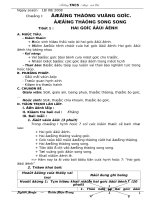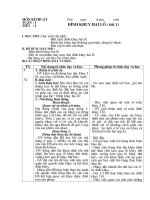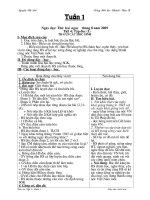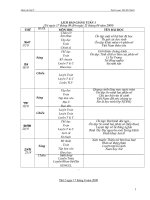- Trang chủ >>
- Mầm non - Tiểu học >>
- Lớp 5
5 2 1 using special talents a
Bạn đang xem bản rút gọn của tài liệu. Xem và tải ngay bản đầy đủ của tài liệu tại đây (5.76 MB, 14 trang )
Suggested levels for Guided Reading, DRA,™
Lexile,® and Reading Recovery™ are provided
in the Pearson Scott Foresman Leveling Guide.
Using Special
Talents
Genre
Narrative
nonfiction
Comprehension
Skills and Strategy
• Compare and
Contrast
• Author’s Purpose
• Answer Questions
Text Features
• Captions
• Charts
• Glossary
Scott Foresman Reading Street 5.2.1
ISBN 0-328-13518-6
ì<(sk$m)=bdfbij< +^-Ä-U-Ä-U
by Sharon Franklin
Reader Response
Using Special
Talents
1. Using a graphic organizer like the one below,
compare and contrast how Lee and Miguel helped
other people.
Topics
by Sharon Franklin
Alike
Different
2. Go back to the chart on page 18. After reading it,
what questions do you still have about how to get
involved in helping others?
3. Which of the vocabulary words contain prefixes?
Explain how the prefixes change the meanings of the
base words.
4. This book contains charts on pages 11, 18, and 22.
Which of the charts was most helpful and why?
Editorial Offices: Glenview, Illinois • Parsippany, New Jersey • New York, New York
Sales Offices: Needham, Massachusetts • Duluth, Georgia • Glenview, Illinois
Coppell, Texas • Ontario, California • Mesa, Arizona
Students Helping Across America
Did you know that every day in cities across the United
States, students like you are helping others?
Each year in Louisiana, a young student and her
younger brother have gone around collecting stuffed
animals for children who live in a homeless shelter.
In New York City, seventy-six students from Harlem
teamed up with four Olympic athletes to transform a
run-down park into a playground featuring a daffodil garden.
And each year in Indiana, a young student has gone
around collecting hundreds of bundles of baby clothes
and other baby items. In the fall she delivers them to a
home for mothers who are having tough times.
Every effort has been made to secure permission and provide appropriate credit for
photographic material. The publisher deeply regrets any omission and pledges to
correct errors called to its attention in subsequent editions.
Unless otherwise acknowledged, all photographs are the property of Scott Foresman,
a division of Pearson Education.
Photo locators denoted as follows: Top (T), Center (C), Bottom (B), Left (L), Right (R),
Background (Bkgd)
Opener: Bill Hustace/Getty Images; 1 Getty Images; 3 Getty Images; 5 Lewis Hine/
Library of Congress; 7 PhotoEdit; 9 Tony Freeman/PhotoEdit; 12 Getty Images; 13 (C, B)
Getty Images; 15 Bill Hustace/Getty Images; 16 Digital Vision; 17 Brand X Pictures; 19
©DK Images; 23 Getty Images
ISBN: 0-328-13518-6
Copyright © Pearson Education, Inc.
All Rights Reserved. Printed in the United States of America. This publication is
protected by Copyright, and permission should be obtained from the publisher
prior to any prohibited reproduction, storage in a retrieval system, or transmission
in any form by any means, electronic, mechanical, photocopying, recording, or
likewise. For information regarding permission(s), write to: Permissions Department,
Scott Foresman, 1900 East Lake Avenue, Glenview, Illinois 60025.
2 3 4 5 6 7 8 9 10 V0G1 14 13 12 11 10 09 08 07 06 05
Students from Harlem
transformed a run-down
park into a playground
using daffodils.
3
Harriet Hanson’s Story
The United States has a long history of young people
making a difference. It was American children from the
past whom you have to thank for your education! Some
courageous children in the 1800s helped change laws
governing child labor. By doing so, they helped ensure
that children in the future would not be denied an
education.
In 1835 Harriet Hanson had her tenth birthday.That
was also the year she began working in a textile factory.
Harriet had to be at work at five o’clock in the morning.
She worked fourteen hours a day from Monday to Friday.
On Saturday she worked eight hours.
Several years before Harriet started working, factory
owners began paying girls less in order to keep profits
high. In 1836 Harriet, along with other girls, decided to
stop working temporarily, to protest the unfair wages.
When the girls who had stopped working lost
their jobs, Harriet joined the Factory Girls’ Association.
Members of this association helped other young people
strike for better wages.They also raised money to help
pay for food and shelter for the children on strike.
4
In the nineteenth century,
young girls and boys worked
long hours in factories
that were dangerous and
unhealthy. Their factory work
kept them from getting a good
education.
5
How Your Resources Can Help
You have now read about several young people who
worked hard to help others. Can you think of times you’ve
helped someone? Maybe you’ve helped a family member.
Perhaps you’ve taken the garbage out for your mom or
helped a brother or sister with homework.
Or maybe you’ve helped a friend. Have you ever lent a
book to a friend who was sick in bed? Or simply helped
a friend with chores? We often help people we know. But
have you ever helped someone you didn’t know?
You might be afraid of helping people you don’t
know because you’re not sure whether you have enough
resources to help them. Resources are things that help you
do a job. Money is a good example of a resource.
Money can certainly come in handy. But think about
the young people you read about earlier in the book.They
made a big difference by using resources that everyone
has: time, desire, willingness, good ideas, and hard work.
What are some resources you could use to help other
people?
These students are using
their time and energy to
help with this garden.
Time and energy
are resources.
6
7
What are your special talents?
A resource can also be something like a
special talent or interest. Are you a great dog
trainer with a well-behaved dog?
Perhaps you and your dog could pay
a weekly visit to a senior care facility.
You and your dog could help a
lonely senior to begin to open up,
like a butterfly that is set to emerge
from a cocoon.
If you are very interested in
something special, you can become an
expert on the topic. Being an expert
can make you a resource for others.
Are you a computer whiz? Try
tutoring people who don’t know a
lot about computers. Are you an
artist? Maybe some of the
things you’ve sketched could
become a mural for your school.
Some people think they don’t
have special talents or interests that
can help other people. Sondra Clark
disagrees. Sondra is a young author
who has received many national
awards for helping other people. She believes everyone
can do something to make others feel good.
8
For Sondra it started when she entered an essay-writing
contest. In her essay, Sondra described why her dad was
great. When she won, she told the contest sponsor to
donate the money to charity. The sponsor was so
impressed that he asked Sondra to be a young
spokesperson for a group dedicated to helping poor and
hungry children in foreign countries. Sondra’s work
helped relieve the suffering of children around the world.
9
Using Your Special Talents
Every one of your talents and interests can be used to
help others and to make a difference in the world.You can
use them in many ways.
What you do depends on your personality and how
you want to use your talents. Some people like to work
closely with only one person.These people might want to
be tutors or read to a person who is blind.
Other people might prefer to work with groups.
These people might want to start a campaign to fight the
disrespect and prejudice among students in schools.
Others might like to organize a drive to collect food or
blankets for people in need.
The chart on page 11 shows some activities that you
can do to help others.These activities all help other
people.They also require your time and effort. Can you
think of any others?
Think about whether you want to work with an
individual or a group. Are you interested in helping
people by teaching them something? Maybe you would
prefer to use your time fundraising or collecting items.
10
Education Donations Political
Social
(Helps people learn
and understand
new things)
(Provides needed
items to people
who might not
have them)
(Influences
decision-makers
and leaders)
(Helps solve a
problem in our
society)
Volunteer to
be a guide for
a special event
in your town.
Collect cans
and bottles.
Donate the
proceeds to
a childcare
center.
Write a letter
to your state
senator about
something you
think should be
done to make
people’s lives
better in your
state.
Volunteer to
help build a
park in a part
of town where
children don’t
have a place to
play.
Create a Web
site about an
important
topic that lots
of people are
interested in.
Contact local
businesses for
holiday gift
donations for
less fortunate
children.
Organize a
petition drive
to tell city
officials about
things you’d
like to change.
Start a school
newspaper
with kids’
stories and
artwork.
Volunteer
to read at
your library’s
preschool story
time.
Join a national
walk-a-thon to
raise money for
a good cause.
Take a poll of
your classmates
to find out
what kinds of
problems you
could help
them solve.
Contact a
high-school
student
organization to
see if you can
work together
on a project.
11
Getting Started on Helping Others
Annie Helps Out
There are lots of fun and interesting ways to help
others. But how do you get started?
The first step is to talk to your parents and other adults,
along with your friends. Ask about what is going on in
your school and community.Talking with people will also
make your activity more fun. When people see how
excited you are about helping others, they might want to
join you.Then you can share the work and satisfaction.
Once you get an idea of what needs to be done, you’ll
have to decide whether you want to join a group or start
your own.
For some ideas on how to get started, let’s follow four
friends while they choose their first projects. Meet Annie,
Miguel, Lee, and Hallanah.
Annie is a great cook. She hopes she will be able to put
her talent for cooking to work someday.
A few weeks ago, Annie’s mother showed her an article
about kids having a bake sale. A national organization
called The Great American Bake Sale had helped the kids
get set up.The kids raised money to fight child hunger.
Annie liked the idea that her baking could help fight
hunger in our country! She is now logging onto the Great
American Bake Sale Web site to find out how to join in.
The Great American Bake Sale is an organization that helps
arrange bake sales for people who want to fight hunger
in the United States. By selling baked goods like the ones
shown here, these sales have raised $1.5 million to help feed
hungry Americans.
12
13
Miguel Helps Out
Lee Helps Out
Meanwhile, Annie’s friend Miguel has decided to work
on a different project. Miguel’s family came to the United
States from Mexico. His parents have told him about
the hardships they faced as migrant workers and how
difficult it was to not have a permanent home.
Miguel’s teacher told him about an organization
that helps build houses for low-income families. Miguel
did a lot of research at the organization’s Web site. He
talked with people at the organization and asked former
volunteers questions about the work they did.This
summer, through the organization, Miguel is going to help
a family of migrant workers build a house!
Lee is having a hard time deciding on a project. He has
so many interests that it is hard for him to choose.
Annie told Lee to check out two Web sites.The first site
was for a program called Make a Difference Day. Lee found
a page called “Project Ideas” and took a quiz.The quiz had
Lee answer questions about whether he wanted to work
alone or with a group. Lee answered questions about his
skills and interests and filled in some boxes about things
his community needs.
When Lee submitted his answers, more than a dozen
project ideas came up on the screen. Lee liked three of
them, but he wanted to look for more ideas.
This student has volunteered her time to an
organization that helps build houses for
low-income families. Without student
volunteers, the houses would be too
expensive for the families to buy.
14
15
The next day, Lee went to the library to continue his
research.The librarian told him about an organization
called Youth Service America.This organization
sponsors National Youth Service Day, a special day when
students work together to make a contribution in their
communities.
Lee visited the organization’s Web site on the library
computer.The site instructed Lee to type in his zip code.
When Lee did, the site showed him what projects were
happening in his area.
Lee, who is very interested in animals and the
environment, saw three activities scheduled for the spring.
One project involved collecting one caterpillar at a
time for a scientist who is trying to figure out why many
butterflies are disappearing. It looked perfect for Lee!
In order to help on the project, Lee needed to call the
person responsible for organizing the volunteer collectors.
This made Lee nervous. He decided to go home and ask
his parents what to do.
When Lee got home, he thought about waiting for
another day to make the phone call.Then he remembered
that it takes courage to make a difference. Lee asked his
mom’s permission to call. She said it was OK, and together
they practiced what he would say.
Lee’s nervousness ended as soon as he called.The
person he talked to was very happy to hear from him!
She invited him to a meeting to learn more. She and
Lee unscrewed the lids and cleaned the jars used for
collecting caterpillars.
By logging on to a Web site, Lee found an
interesting project that involved finding
caterpillars (like the one shown below) and
cleaning jars (like the ones shown to the right).
16
17
Reviewing How It’s Done
You’ve now seen how three young people who had
never volunteered before got started. All of them wanted
to do something they were interested in. Annie wanted to
use her baking talents and found out about the Great
American Bake Sale by talking with her mother. Miguel’s
teacher found out about an organization that helps build
houses. Miguel did research on the organization and the
work it does. Now he will be able to help build a house!
Lee went to the library. There, he looked up projects on
the Internet that interested him. All of these students had
to do research and contact people and organizations.
Look at the chart below. It shows the steps to take to
start helping others. If you’re unsure about any part of the
process, you can always refer back to the chart to refresh
your memory.
Seven Steps to Get Started
on Helping Others
1. Identify my interests and talents.
2. Talk to other people.
3. Find out what is happening in my community.
4. Find out about needs in my community.
5. Research projects and organizations.
6. Contact people to get involved.
7. Get started!
. . . . . . . . . . .
18
In contrast to Annie, Miguel, and Lee, Hallanah is
an experienced volunteer. In kindergarten her mom
encouraged her to join her on walk-a-thons. Since then she
has walked more than fifty miles. For each mile Hallanah
walked, friends and family members donated money for
cancer and cerebral palsy research. Last year she signed
up for a National Youth Service Day car wash that raised
money for a local preschool.
Hallanah had been thinking about her talents and
interests. Her friends and teachers tell her she is a good
communicator. Hallanah also loves computers. She wanted
to combine her talents and interests in a way that would
help others.
On the way to school one morning, a big smile spread
across Hallanah’s face. She had realized what she wanted
to do! Before Hallanah did anything else, she knew that
she would first have to speak with her computer teacher.
19
How Hallanah Helped Out
After school Hallanah rushed down to the computer
room. She asked her computer teacher if she could create
her own Web site.
Her teacher liked the idea! He agreed to let Hallanah
make a site that would help students become volunteers.
Her site would have information about volunteer
opportunities with all different kinds of organizations.
Hallanah also decided to include stories about young
people who volunteered.Those young people would be
able to see pictures of themselves and their projects on
the Web site. They would also be able to read about how
others got started and the success they’ve had.
Hallanah worked on her Web site for several weeks.
She found that making a Web site about volunteering took
a lot of the same skills as being a volunteer.
She had to talk to a lot of people to gather information
about volunteer opportunities in her community. She
talked with people who work for the city.These people
work in the library, the parks department, the police
department, and the public works department.They all
wanted to be listed on Hallanah’s Web site.
Hallanah also talked to the directors of several
nonprofit organizations.The director of the hospital,
several preschools, and the homeless shelter all had
volunteer opportunities for her to list.
Hallanah’s Web site soon blossomed with opportunities
for students to help out and volunteer! Below are some
of the opportunities that Hallanah’s Web site offered.
Library
vo
needed lunteers
! Read
st
to pres
chooler ories
s.
eeds
chool n
s
e
r
p
l
ho
a
Loc
l aides w
o
o
h
c
s
r
afte
dren.
love chil
Parks Department volunteers
needed to teach summer
arts and crafts and supervise
camp playgrounds.
Public Work
sD
needs summ epartment
er voluntee
rs to
help improv
e animal ha
bitats.
20
oking for
Hospital lo lay games
p
students to atients.
p
g
with youn
oking for a
artment lo
p
e
vise
D
ce
li
o
P
boys to ad
d
n
a
ls
ir
g
affect
few good
blems that
ro
p
n
o
ce
li
po
mmunity.
le in our co
p
o
e
p
g
n
u
yo
New Beg
innings S
he
looking f
or tutors lter
for
young ch
ildren.
21
Hallanah Makes Her Picks
Hallanah had to do a lot of research about national
organizations. She visited more than twenty-five Web
sites and looked at the kinds of activities they sponsored.
She also compared them with each other to see how the
opportunities they offered were both alike and different.
Hallanah thought that displaying that kind of information
on her Web site would help students find just the right
project! The chart below lists the national organizations
that Hallanah recommended the most, based on the
opportunities for volunteering that they provide.
Hallanah’s Top Picks
• American Red Cross
• Boys and Girls Club of America
• Girl Scouts of America
Hallanah decided to profile a different
student each week on her Web site. For her
first profile she decided to pick someone
who was especially inspiring and who had
made a big difference.
Hallanah picked Melissa Poe. When
Melissa was nine, she wrote a letter to the
President, asking him to help clean up the
environment. Her letter soon appeared on
more than 250 billboards across the country.
Melissa even went on television to get her
message out. Her club, Kids For a Clean
Environment, or Kids F. A.C.E., grew and grew.
Today, it has chapters all over the world, and
its members have helped plant more than a
million trees! It’s all thanks to a young girl
who wrote a letter. As you can see, students
can accomplish pratically anything when
they decide to help out!
• Great American Bake Sale
• Make a Difference Day
• National Park and Recreation Association
• Youth Service America
. . . . . . . . . . . .
22
23
Reader Response
Glossary
caterpillar n. the wormlike
larva of insects such as
butterflies and moths.
migrant adj. migrating;
roving; traveling from one
area to another.
cocoon n. case of silky
thread spun by the larva
of various insects, to live
in while it is developing
into an adult.
sketched v. to have made
a rough drawing of
something.
disrespect n. a lack of
respect for someone or
something.
unscrewed v. to have
loosened by having taken
off or turned.
1. Using a graphic organizer like the one below,
compare and contrast how Lee and Miguel helped
other people.
Topics
Alike
Different
emerge v. to come into
view or into the open.
2. Go back to the chart on page 18. After reading it,
what questions do you still have about how to get
involved in helping others?
3. Which of the vocabulary words contain prefixes?
Explain how the prefixes change the meanings of the
base words.
4. This book contains charts on pages 11, 18, and 22.
Which of the charts was most helpful and why?
24









